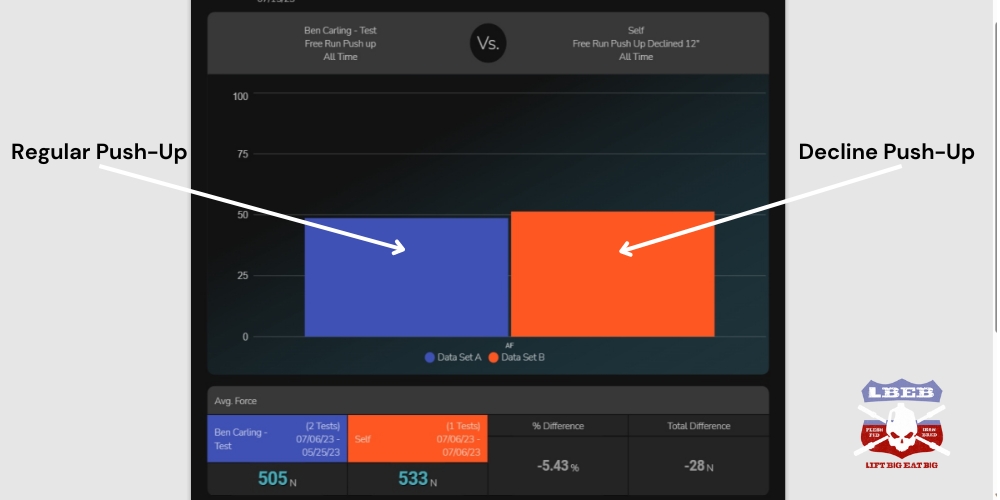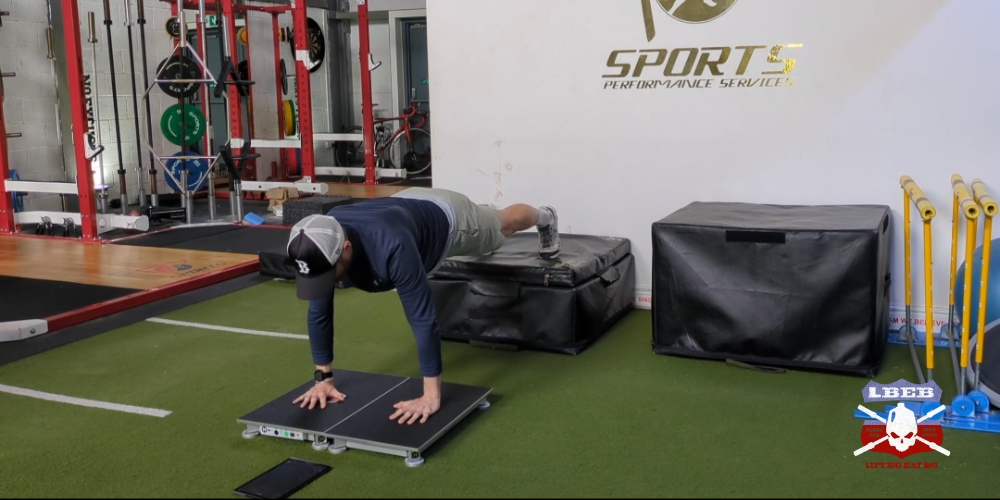Push-ups! One of the first exercises you probably did as a young kid in your bedroom. Or a regularly performed exercise when you’ve donned a tight-fitting t-shirt before a night out. We’ve all been there!
I’m sure most of us have experimented with decline push-ups, but what is the difference between the two and which is harder?
Our force plate data shows that decline push-ups generate more force making decline push-ups harder than regular push-ups. The higher your feet, the more strength is required from your chest and shoulders.
Let’s take a deeper look into this. How does average force generated change over 8 push-ups at 4 different angles – a flat, regular push-up on the floor and then declined push-ups at 12″, 18″, and 24″ heights?
Table of Contents
Decline vs. Regular Push-Ups Differences
Foot Position
The most obvious difference is the height of the feet. The higher you raise your feet, the more demand is placed on the chest and shoulders. The width of foot positions should remain the same for both variations, which are hip-width apart.
Force Generation
There wasn’t much difference between the 3 selected heights of decline push-ups (12″, 18″, & 24″).
For example, a 12″ decline push-up produced nearly 35 Newtons more on average per repetition of a set of push-ups (based on a set of 8 push-ups).

To put it in a context that might be more understandable, when you convert force (N) to weight (Kgs), a 12″ decline push-ups produce a force of approximately 71.43% of total body weight.
In comparison, flat push-ups produce a force that is approximately 64.93% of total body weight.
Muscles Worked
The same muscle groups in both variations are worked, but some are stressed more than others. The pectorals, deltoids, triceps, and abdominals are the primary muscle groups being worked.
However, the decline push-up will require more work, predominantly from the pectorals and deltoids – particularly the anterior and medial deltoids and triceps.
Difficulty
Given the greater emphasis on the muscle groups in the decline push-up, this is clearly a more challenging exercise than its flat version counterpart. If you are new to push-ups, consider the flat version a starting point and progress to decline push-ups.
How Does Decline Angle Affect The Push-Up?

The great thing with exercises is that they only need a minor manipulation to change the outcome.
This happens because the kinetic chain changes, so raising your feet from the floor to a box to create a decline push-up increases the demand on the torso and upper limbs.
There is more body weight (load) that the torso, chest, back, shoulders, and triceps have to manage.
Interestingly, we found that there isn’t much difference between placing your feet on a 12″ box, an 18″ box, or a 24″ box.
There was around 60 N, on average, between the varying heights. In this example, it equated to an additional 6kg in mass, which is about 7.79% extra compared to the flat push-up.
How To Decline Push-Up
- The easiest way to get into position is to start in a regular push-up position in front of the box you wish to raise your feed onto. Hands should be just wider than shoulders and elbows around a 45-degree position with wrists under elbows.
- At this point, lower your knees to the floor to provide additional stability when you raise your first foot onto the box so your toe is in contact with the box.
- Lift your foot onto the box and keep your leg straight. Once it’s in position, lift your second foot from the floor to the box. Your feet should be hip-width apart.
- You are now in your set position to start performing decline push-ups.
- Breathe in and brace your core. Lower your chest to the floor while maintaining a strong core and straight body position.
- On the descent, elbows should be around 45 degrees and not externally rotated towards the shoulders.
- When you have reached the end of your descent, push into the ground, extend your arms, and return to the start position. A good cue is to ‘push the floor away.’
I recommend a tempo of 1-1-1. This means the descent should be around 1 second; you should pause at the bottom for 1 second and ascend for 1 second. If you want to make it harder, slow the eccentric (descent) phase down to 2-3 seconds.
Decline Push-Up Benefits
Target Additional Muscles
By raising your feet, the decline push-up emphasizes your anterior deltoids and the upper section of your pectoral.
Harder To Perform
The degree of difficulty is more challenging. The force plate data tells us this. We know that the target muscles produce more force in the decline push-up. This is because there is more load (body weight) being moved.
How To Regular Push-Up
- Start by kneeling on the floor with your hands just wider than your shoulders and elbows around a 45-degree position with wrists under your elbows.
- Extend one leg to a straight position so your toe is in contact with the floor, followed by your other leg.
- You are now in your set position to start performing push-ups. Your feet should be hip-width apart.
- Breathe in and brace your core. Lower your chest to the floor while maintaining a strong core and straight body position. You should lead with your chest and not let your hips drop or collapse towards the floor.
- On the descent, elbows should be around 45 degrees and not externally rotated towards the shoulders.
- When you have reached the end of your descent, push into the ground, extend your arms, and return to the start position. A good cue is to ‘push the floor away.’
I recommend a tempo of 1-1-1. This means the descent should be around 1 second; you should pause at the bottom of the ascent for 1 second and ascent for 1 second. If you want to make it harder, slow the eccentric (descent) phase down to 2-3 seconds.
Regular Push-Up Benefits
A Perfect Starting Point For Beginners
Regular push-ups are a perfect starting point for beginners and youth athletes. They provide a great platform to gain and improve upper body strength, but can quickly be regressed if you find them too challenging.
An easy regression is to drop your knees to the floor while maintaining the torso and arm position and carry on with your push-ups.
Do Them Anytime, Anywhere!
No equipment is needed. They can be done anytime, anywhere, with no excuse. On the gym floor, your bedroom, or lounge floor, take it outside to your garden or include them in a daily walk in a park.
Decline vs. Regular Push-Ups: Which Is Better?
On balance, the decline push-up is better than the regular push-up. Yes, it’s more technical, but the additional load per rep, per set, and the accumulative effect will accelerate upper body strength gains. Additionally, it brings your anterior deltoids into play which play a crucial role when developing chest strength.
